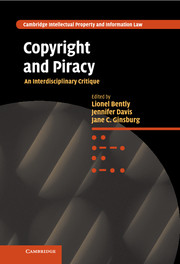Book contents
- Frontmatter
- Contents
- Notes on the contributors
- Editors' preface
- Table of cases
- Table of statutes
- Part I Introduction
- Part II History
- Part III Comparative Law
- Part IV Economics
- Part V Linguistics
- 8 ‘Substantial similarity of expression’ in copyright infringement actions: a linguistic perspective
- 9 Refining notions of idea and expression through linguistic analysis
- Part VI Computer software
- Part VII Information studies
- Part VIII Literature
- Part IX Art
- Part X Sociology/music
- Part XI Criminology
- Bibliography
- Index
- References
8 - ‘Substantial similarity of expression’ in copyright infringement actions: a linguistic perspective
from Part V - Linguistics
Published online by Cambridge University Press: 17 November 2010
- Frontmatter
- Contents
- Notes on the contributors
- Editors' preface
- Table of cases
- Table of statutes
- Part I Introduction
- Part II History
- Part III Comparative Law
- Part IV Economics
- Part V Linguistics
- 8 ‘Substantial similarity of expression’ in copyright infringement actions: a linguistic perspective
- 9 Refining notions of idea and expression through linguistic analysis
- Part VI Computer software
- Part VII Information studies
- Part VIII Literature
- Part IX Art
- Part X Sociology/music
- Part XI Criminology
- Bibliography
- Index
- References
Summary
Non-literal copying and literary copyright
Commenting on the resemblance between two designs with similar patterns of stripes and flowers in Designers' Guild, Lord Hoffmann explains how there can still be infringement without literal copying. He points out that:
The original elements in the plot of a play or a novel may be a substantial part, so that copyright may be infringed by a work which does not reproduce a single sentence of the original. If one asks what is being protected in such a case, it is difficult to give any answer except that it is an idea expressed in the copyright work.
‘It is difficult’, says Lord Hoffmann, ‘to give any answer’. The answer he does give (that the idea is ‘expressed’ in the copyright work) neatly encapsulates the challenge presented by what is called the ‘idea–expression dichotomy’ in copyright law. That dichotomy, visited and revisited from different points of view in judicial statements and in the academic literature, forms the main topic of this chapter. My aim is to consider whether linguistic description can add anything to its clarification.
The basic distinction between ‘ideas’ and ‘expression’ can be simply stated: ideas are not protected (and so cannot be monopolised by a copyright holder, remaining available for everyone to use) but the specific expression of an idea is. This is an established concept of Anglo-American copyright law, based on the contribution made by public communications to the ‘marketplace of ideas’.
- Type
- Chapter
- Information
- Copyright and PiracyAn Interdisciplinary Critique, pp. 147 - 193Publisher: Cambridge University PressPrint publication year: 2010



